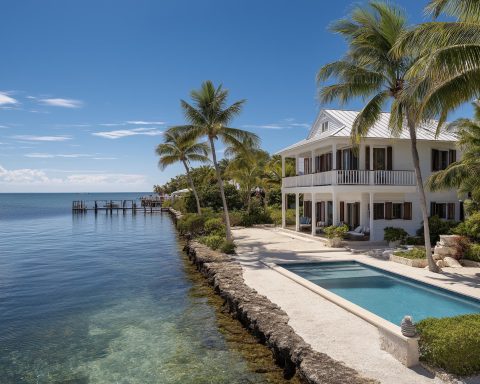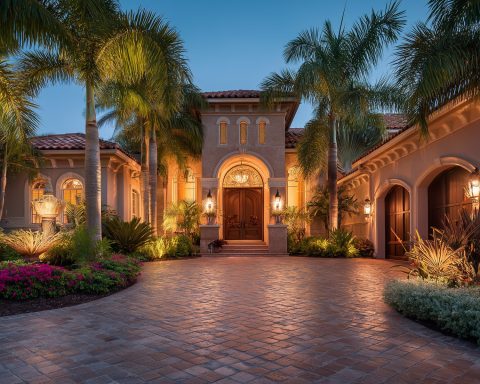- Middle East Mega-Deal: UAE developer Arada acquired a 75% stake in London’s Regal for $680 million, marking a major Gulf foray into UK real estate reuters.com. Arada’s chairman cited “strong demand for residential space” in London as a driver for this expansion reuters.com.
- US Housing Rebound Signals: The U.S. Federal Reserve’s first rate cut since 2024 sparked optimism in housing. The 30-year mortgage fell to a 6.49% 11-month low, fueling a 9.2% jump in weekly mortgage applications reuters.com reuters.com. Homebuilder stocks surged 15% this quarter, outpacing the S&P 500 reuters.com.
- European Commercial “Zombieland”: Europe’s commercial real estate market remains moribund, with near-decade low sales volumes reuters.com. An industry executive warns of “‘zombieland’…no recovery, stranded assets, no liquidity” in parts of the market reuters.com. Even prime offices and malls struggle to find buyers amid flat sales and cautious investors.
- China’s Property Crisis Drags On: China’s housing slump showed no turnaround. Evergrande’s delisting and peers’ debt woes underscore a sector in turmoil. Analysts say “a clear turnaround…not yet in sight” and urge urgent stabilization measures reuters.com. A Deloitte restructuring expert bluntly noted “there’s no light at the end of the tunnel” for developers reuters.com.
- India Attracts Investment: In contrast, India drew $3.0 billion of real estate investment in H1 2025 lokmattimes.com. Foreign capital made up 52% of inflows, and residential and office assets led activity lokmattimes.com. Investors remain confident as demand for high-quality space stays robust, per a Colliers report.
- Latin America Steady Amid Easing: No major disruptions hit Latin America’s property markets during the period. Brazil and Mexico are benefiting from relative economic stability – their equity markets trade near record highs amid softening monetary policy reuters.com. Mexico’s central bank is even poised to trim rates, supporting real estate financing.
- African Markets & Reforms: Egypt’s developers pressed for reforms to boost stability, proposing a new platform to regulate land sales and allocations and improve market oversight dailynewsegypt.com. In South Africa, interest rate cuts (repo rate down to 7% in August) aim to spur a housing market still 16% below pre-pandemic sales volumes privateproperty.co.za globalpropertyguide.com, with affordability improving modestly.
North America: Housing Hopes and Commercial Caution
United States – Residential: The U.S. housing sector showed glimmers of revival over the weekend. Following a Fed rate cut on Sept 17, the average 30-year mortgage rate slid to 6.49%, its lowest since late 2024 reuters.com. This decline – the sharpest weekly drop in six months – unleashed pent-up demand: mortgage applications jumped 9.2% to a three-year high reuters.com. Lenders saw a surge in refinancings and purchase loans, suggesting buyers are tiptoeing back as borrowing costs ease. “The Fed is rebooting the easing cycle…homebuilders is one of [the areas] that may stand to benefit,” noted Angelo Kourkafas, an Edward Jones strategist reuters.com. Indeed, a key housing stock index is up 15% this quarter, outperforming the S&P 500 reuters.com. Homebuilder shares like D.R. Horton and Toll Brothers have rallied over 20–30% in anticipation of lower mortgage rates boosting sales reuters.com. While sales data earlier in the summer was weak (new home sales fell in July amid high rates), the tide may be turning – inventory is inching up and price growth leveling off, hinting the worst of the slump has passed reuters.com.
United States – Commercial & Land: Commercial real estate (CRE) in the U.S. remains a mixed picture. Industrial and multifamily properties continue to see relatively steady demand (helped by e-commerce and housing shortages), but office and retail segments are struggling with high vacancies and credit stress. Refinancing large office towers has become challenging with interest rates that – despite the recent cut – are well above pandemic lows. Market sentiment toward U.S. real estate has “soured” in 2025 reuters.com, mirroring Europe’s cautious tone. High-profile defaults on office buildings earlier this year and stagnant leasing in some downtowns underscore the challenges. However, land transactions and development sites are attracting interest where growth prospects are solid. Notably, foreign investors signaled new appetite for U.S. infrastructure and land: Egypt’s richest man, Nassef Sawiris, told the FT he plans to invest up to $50 billion in U.S. infrastructure projects reuters.com – a vote of confidence that could extend to large-scale property developments (e.g. logistics parks and data centers on American soil). Overall, North America’s outlook is cautiously optimistic: lower financing costs and government initiatives (like Canada’s new C$13 billion “Build Canada Homes” agency to spur affordable housing reuters.com) may gradually unlock demand, but regional disparities persist (some Sunbelt housing markets are rebounding, whereas pricey coastal cities remain softer).
Canada & Mexico: In Canada, housing affordability is front-and-center. While not a headline over Sept 21–22, just a week prior Prime Minister Mark Carney launched a federally backed housing developer with C$13 billion to build homes for low-income and middle-class families reuters.com reuters.com – a policy response to Canada’s “housing crisis” of high rents and home prices. This move, alongside recent Bank of Canada rate pauses, signals North America’s pivot toward supporting residential construction. In Mexico, economic observers note that the Banxico (central bank) is expected to cut interest rates soon, following the Fed’s dovish turn reuters.com. Such monetary easing in Mexico would ease financing for real estate projects. Both Mexico and Canada also continue to see industrial real estate growth driven by nearshoring: demand for warehouses and factories has risen as companies relocate supply chains closer to the U.S. market (though specific deals weren’t reported on Sept 21–22).
Europe: Divergent Markets and “Zombie” Assets
Western Europe – Commercial: Hopes of a European real estate rebound in 2025 have largely faltered. Across major markets, commercial property sales are stuck at near-decade lows, defying predictions of recovery reuters.com. Through mid-year, volumes were roughly half of 2019 levels as investors remained on the sidelines. A Knight Frank analysis showed cross-border investment into Europe, Middle East & Africa fell ~20% year-on-year in Q2 – the worst April-June in a decade reuters.com. “We have ‘zombieland’… no recovery, stranded assets, no liquidity coming back,” warned Sebastiano Ferrante, head of European real estate at PGIM, describing parts of the market reuters.com. The harshest pain is in out-of-favor segments: office towers in secondary locations and aging shopping malls have few buyers, and even trendy sectors like data centers have cooled reuters.com. In Germany, Europe’s largest economy, a severe property slump continues – property sales fell another 2% in H1 2025, hitting the already fragile market reuters.com. One emblem of distress, Frankfurt’s 45-story Trianon office skyscraper (whose owners went insolvent), has been put up for sale by administrators reuters.com, a rare test of investor appetite in a down market. The strategy so far for lenders and owners has been “extend and pretend” – extending loan maturities and hoping conditions improve reuters.com. But some banks and funds are now starting to offload distressed assets, acknowledging that the outlook remains weak reuters.com.
At the same time, private capital is circling for opportunities. Alternative lenders raised nearly $40 billion in Europe in H1 2025 – almost double the new equity raised by real estate funds reuters.com. This suggests some investors prefer real estate debt plays or are holding dry powder for bargains. A survey by industry group INREV showed investor sentiment toward European real estate in mid-2025 was the gloomiest in over a year reuters.com. Interest rates remain a critical factor: the European Central Bank’s previous hikes have repriced assets, but now inflation is easing and rate cuts are expected in 2026, which could eventually stabilize yields. As one investment manager, Cécile Retaureau of Phoenix Group, put it: parts of the market (like prime logistics and hotels) are recovering well, “however there are… sectors where there is almost no liquidity and more pain to come” before values truly bottom reuters.com.
United Kingdom – Housing: In UK residential real estate, a slow cooldown is underway. New data showed asking prices for homes listed in late summer were 0.1% lower than a year ago – the first annual decline in over 18 months reuters.com. High mortgage rates and economic uncertainty have finally taken some heat out of Britain’s housing market. Month-on-month, asking prices did tick up 0.4% in early September, but that rise was smaller than the usual seasonal bump reuters.com. Industry experts tie the softness partly to political uncertainty: “Rumours of property tax changes…with the Budget not until end of November…extended uncertainty can affect market activity, especially in the higher price brackets,” noted Colleen Babcock of Rightmove reuters.com. Indeed, the slight annual price drop was led by London and southern England, where expensive homes are more sensitive to tax policy and buyers have become skittish reuters.com. On the rental side, there’s a silver lining for tenants: rent growth has slowed to its lowest pace in four years. Average UK rents in early September were about 2.4% higher than a year prior reuters.com – still rising, but a marked cooldown from the >10% spikes seen in 2022. Rental supply has improved modestly, and lower immigration plus better first-time buyer options are easing competition for rentals reuters.com. Overall, UK housing activity is muted but stable. The Bank of England held its policy rate at 4% in its mid-September meeting reuters.com after cutting rates earlier in the summer, which should gradually relieve mortgage burdens. A Reuters poll indicates British house prices will rise only ~2.6% in 2025, slower than previously expected reuters.com – a boon for first-time buyers regaining affordability. As one London agent observed, improving wage growth and slightly cheaper mortgages are “sparking greater buyer interest” and luring long-sidelined buyers into the market reuters.com. Still, high-end London remains subdued due to what one expert called a “‘high end’ problem” – tax and political headwinds that deter wealthy domestic and overseas buyers reuters.com.
Continental Europe – Mixed Outlook: Other parts of Europe saw varied developments. In France and Spain, housing markets are flat to slightly rising, with low unemployment supporting demand even as credit conditions tighten. Italy is benefiting from foreign buyers (especially for luxury and vacation properties), though transaction volumes have slowed. Meanwhile, policymakers are active: for instance, Germany has debated incentives for housing construction as new building permits plunge amid high costs. No major policy announcements occurred on Sep 21–22, but the general trend is European governments grappling with housing shortages – e.g. Berlin’s ongoing efforts to accelerate permitting and a proposed French law to convert vacant offices to apartments. In the land sector, Europe is seeing creative reuse: developers are eyeing idle land for logistics and data centers, given the scarcity of prime urban plots. However, land values in peripheral areas are under pressure, paralleling the broader caution in real assets.
Asia-Pacific: China’s Turmoil vs. India’s Resilience
China – Ongoing Real Estate Slump: China’s property market remained in the headlines for grim reasons. The crisis that began with developer Evergrande’s default in 2021 is still unfolding with little resolution. By Sept 22, China Evergrande Group – once the country’s top-selling developer – had been formally delisted from the Hong Kong stock exchange after failing to execute a debt restructuring reuters.com. Evergrande’s collapse (with over $300 billion in liabilities) exemplifies the depth of the downturn. Dozens of developers have defaulted since 2021 amid plunging home sales and frozen credit reuters.com. A Reuters analysis noted that more than $140 billion (over 70%) of Chinese developers’ offshore bonds have defaulted since the crisis began reuters.com, and most are still bogged down in protracted debt workouts reuters.com. Despite a flurry of policy support – interest rate cuts, lower down-payment requirements, and home purchase subsidies in some cities – buyer confidence remains damaged. New home prices have been declining modestly month-on-month; July saw a 0.3% drop nationally, though the pace of declines eased in major cities reuters.com. Analysts say establishing a price floor is crucial to restoring confidence given Chinese households’ heavy exposure to real estate wealth reuters.com. “A clear turnaround and stabilisation are not yet in sight. The government should roll out a full set of property-market stabilisation measures without delay,” urged Li Kai, a Beijing-based fund manager, as prices kept sliding reuters.com. Even formerly resilient segments like the resale market are seeing continued price falls reuters.com. Construction activity is stalled; investment in property development fell 12% year-on-year in the first seven months of 2025 reuters.com.
Regulators are walking a tightrope, trying incremental measures: some cities eased home purchase restrictions and cut mortgage rates for first-time buyers. But so far it’s not enough. A restructuring expert, Glen Ho of Deloitte, remarked bleakly on China’s property outlook: “There’s no light at the end of the tunnel” for developers struggling to renegotiate debt while sales slump reuters.com. The broader impact is significant – real estate once made up roughly a quarter of China’s GDP, and its downturn is weighing on the overall economy reuters.com. That’s prompted Beijing to emphasize housing completions (to deliver pre-sold units to buyers) and explore new financing tools for developers. Over Sept 21–22, no new major rescue policies were announced, but expectations are growing that authorities will have to take more drastic action (such as setting up a bad-debt fund or easing home purchase curbs nationally) to break the negative cycle. In the meantime, China’s woes are spilling over regionally: construction material suppliers, banks, and even global commodity markets are feeling the chill from the retrenchment of the world’s largest real estate sector.
India – Strong Investment and Growth: In contrast to China, India’s real estate sector is showing robust resilience. A fresh report released Sept 22 highlighted that India attracted $3 billion in real estate investments in the first half of 2025 lokmattimes.com. While this was slightly lower year-on-year, investor interest “remained intact” according to Colliers India lokmattimes.com. Notably, foreign investors contributed $1.6 billion (52% of the total) in H1, while domestic investment surged 53% year-on-year as local institutional buyers gained confidence lokmattimes.com. The capital is chasing opportunities across asset classes: residential and office assets together accounted for over half of inflows (with around $800 million into housing) lokmattimes.com. There’s also growing interest in early-stage development – land acquisitions and construction financing picked up significantly, indicating developers are moving ahead on new projects lokmattimes.com. Colliers’ CEO for India, Badal Yagnik, noted that demand for high-quality space is strong, helped by reforms like simpler GST tax rules and expectations of higher consumer spending during the festive season lokmattimes.com. India’s property market is benefiting from a booming economy (projected ~6% GDP growth) and urbanization trends. Mumbai, Delhi and Bangalore continue to see healthy office leasing by IT and financial firms, and residential sales are steady with only moderate price appreciation. Investors have taken note: India has risen to the 4th spot in Asia-Pacific for cross-border real estate investment, up from 7th previously lokmattimes.com. This reflects global capital rotating into India as a growth play while China stagnates.
Other Asia-Pacific Developments: Several other APAC markets saw noteworthy developments around this time. Japan’s real estate is on an upswing – property prices in Tokyo and other major cities have climbed enough that even so-called “stigmatized” homes (properties where a death occurred) are finding buyers reuters.com. Ultra-low interest rates and a scarcity of land keep Japan’s housing demand high. Australia and New Zealand are emerging from their housing corrections: Australia’s house prices rose 0.7% in August as buyer demand outstripped limited supply reuters.com, and New Zealand’s market is showing mixed signals with some regions ticking up while others remain cautious reuters.com. In Southeast Asia, government initiatives are notable: for example, Singapore is tightening rules to cool its red-hot housing market, while Malaysia and Thailand are courting foreign buyers and expats with residency programs tied to real estate investment. No major policy changes occurred exactly on Sep 21–22, but the general trend is active management of property markets to balance growth with affordability. Land sector news in Asia included large infrastructure-linked real estate plays: in Indonesia, a new capital city project is unlocking vast tracts of land for development (with reports of significant progress in September), and in Vietnam, industrial parks continue to expand thanks to manufacturing inflows.
Finally, Asia’s commercial real estate investment has been buoyed by some big deals outside China. Japan saw marquee transactions (e.g. the sale of a portfolio of hotels), and Singapore’s sovereign wealth funds have been acquiring logistics assets across the region. In Hong Kong, however, commercial rents and values keep sliding under higher interest rates and lower mainland investor demand. Analyst outlook: Regional experts expect Asia-Pacific real estate to diverge: India and Southeast Asia are likely to stay on a strong footing, China needs substantial intervention to stabilize, and developed markets like Japan and Australia should see moderate growth aided by accommodative or neutral monetary policy.
Latin America: Stability and Regional Highlights
Latin America’s real estate markets did not generate major breaking news in the Sept 21–22 window, but the backdrop is one of relative stability with positive undercurrents. Thanks to easing inflation and interest rate cuts in the region, economic conditions are improving – which bodes well for property sectors.
Brazil & Mexico – Market Resilience: The two largest Latin American economies, Brazil and Mexico, are seeing robust investor confidence that also extends to real estate. Both countries’ stock markets are near all-time highs and their currencies have strengthened, reflecting global investors’ attraction to Latam assets reuters.com. In Brazil, the central bank has been steadily cutting rates from last year’s 13.75% peak; by September 2025 the Selic rate was around 12.75% and expected to fall further. Lower borrowing costs are already spurring housing and construction activity – mortgage lending picked up in Brazilian cities through Q3, and developers resumed some projects put on hold. The affordable housing segment, backed by government subsidy programs (Casa Verde e Amarela), continues to drive volumes. Commercial real estate in Brazil is mixed: prime logistics warehouses are in high demand (thanks to e-commerce growth), while office vacancy in São Paulo remains elevated around 25%. Brazilian developers also attracted venture investment: one example is Eles, a fintech focused on real estate liquidity, which raised $6 million around Sept 21 to expand its platform thisweekinfintech.com. This indicates innovation in the sector, even if overall investment volumes are modest.
Mexico’s story is similarly one of cautious optimism. The Bank of Mexico held its benchmark rate at a high 11.25% for most of 2025 but signaled a possible 25 bps cut in the upcoming meeting reuters.com, given cooling inflation. The prospect of monetary easing is bullish for Mexican real estate. Already, U.S. nearshoring trends have led to industrial real estate booms in northern Mexico – vacancy in key logistics hubs like Monterrey and Ciudad Juárez is near record lows, and developers are racing to add new warehouses. On the residential side, Mexico’s housing demand remains strong, though high interest rates had tempered sales earlier in the year. In response, developers pivoted to building more middle-income and rental housing, often with financing from public trusts (Fibras). Foreign investment is also noteworthy: as international investors diversify away from China and other areas, some have increased allocations to Mexico, Brazil, and Chile. “The Latam story is easier to tell now…stocks are cheap and there is a lack of options in emerging markets,” one investment head at Itau BBA said, noting Latin markets’ appeal in 2025 reuters.com. While that quote refers to equities, the improved sentiment extends to property insofar as stable macro conditions help real estate yields look attractive.
Andean & Other Markets: Elsewhere in Latin America, trends are more localized. Chile cut interest rates aggressively in 2025, which is stimulating its housing market – mortgage rates have come down and home sales in Santiago have started to recover from a slump. Colombia is similarly benefiting from rate cuts, though high construction costs are a concern. In Argentina, the real estate market is a peculiar case: with rampant inflation and currency controls, property is often traded in cash (USD) and has seen prices actually fall in dollar terms in recent years. Interestingly, in the run-up to Argentina’s October elections, some overseas investors and expatriates started scouting Argentine real estate, betting on a post-election economic rebound. A report from an industry site noted new developments in Buenos Aires targeting foreign buyers, highlighting long-term value opportunities given depressed prices adventuresincre.com. However, any recovery there depends on broader economic reforms. Peru and Central America had no major news, but tourism-driven real estate (hotels, resort residences) is gradually improving after the pandemic, especially in Costa Rica and Panama.
By and large, Latin America’s property markets in late 2025 are quietly progressing. High interest rates had curbed activity, but as inflation retreats, central banks from Brazil to Chile are cutting rates, which should reduce financing costs for developers and buyers. The absence of a crisis is noteworthy – unlike 2024 when Chile had a construction sector crunch or 2023 when Brazil’s corporate real estate had some defaults, 2025 has been stable. The key theme is investor diversification: global funds are underweight Latam real estate, so even small shifts can bring noticeable capital. As one hedge fund manager, Rob Citrone, pointed out, “small changes to large [U.S.] markets can have big impacts on smaller markets, such as most in Latam” reuters.com. This dynamic suggests Latin American real estate could see upside if international investors continue to rotate into the region’s high-yield opportunities amid a more benign interest rate outlook.
Africa & Middle East: Growth Ambitions and Strategic Moves
Middle East – Gulf’s Global Expansion: The Middle East property sector, especially in the Gulf, is in a phase of rapid growth and outward expansion. The headline development was Arada’s acquisition of London-based Regal announced Sept 22 reuters.com. Arada, a Sharjah (UAE)-based developer founded in 2017, is investing 2.5 billion dirhams (~$680 million) to buy 75% of Regal, which has a pipeline of 10,000 housing units in the UK reuters.com. This deal marks Arada’s second international venture (after a project in Australia last year) and reflects a broader trend: cash-rich Gulf developers deploying capital into Western real estate. “London is one of the world’s leading cities, and our expansion into this market represents a strategic step…in response to strong demand for residential space,” said Sheikh Sultan bin Ahmed Al Qasimi, Arada’s chairman reuters.com. Arada plans to triple Regal’s development pipeline within three years, renaming it “Arada London” and focusing on housing projects. The move comes as Gulf real estate markets boom at home – high oil revenues and economic diversification have fueled record property sales in Dubai, Riyadh, and Doha over the past two years. Gulf developers are leveraging those gains to diversify abroad. Reuters notes that Damac, Aldar, and Modon (other major UAE firms) have all launched development arms targeting UK projects recently, via subsidiaries or joint ventures reuters.com.
The home markets remain very strong. In Dubai, year-to-date real estate transactions are at all-time highs (helped by an influx of foreign buyers and investors). Premium properties in Dubai and Abu Dhabi continue to see double-digit price growth annually as demand outstrips supply. Saudi Arabia, amid its Vision 2030 transformation, is pouring resources into new cities and resorts (NEOM, Red Sea Project, etc.), with tens of billions in contracts awarded. A Saudi report noted real estate transaction value jumped 19% in recent months, reaching about $4.1 billion in a recent 3-month period arabnews.pk. The Saudi government also approved a landmark law in July to allow foreign ownership of real estate by non-residents (effective Jan 2026) pinsentmasons.com, aiming to attract global investors. These developments underscore the region’s liberalization and growth trajectory.
Middle East – Commercial & Industrial: The commercial real estate scene in the Middle East is robust, particularly in retail and hospitality. For instance, hotel occupancy and new hotel developments are surging on the back of tourism booms in Dubai, Saudi Arabia (religious tourism and upcoming Expo 2030 in Riyadh), and Qatar (post-World Cup momentum). Industrial and logistics real estate is also expanding as Gulf economies diversify – e.g. Abu Dhabi is investing heavily in free zones and warehousing for manufacturing. During the week in question, one notable update was a Qatari real estate report that early September saw over QAR 394 million (~$108 million) in property sales in just one week arabnews.com, indicating an active market. Additionally, in Oman, Wujha Development launched two landmark mixed-use projects (“Uptown Muscat” and “Central 7”) in the Knowledge Oasis tech park, signaling confidence in Omani real estate growth (announced Sept 21). Such projects highlight how even smaller Gulf states are ramping up real estate development as part of economic growth strategies.
Africa – Reforms and Challenges: Across Africa, real estate developments are more country-specific. Egypt, the continent’s third-largest economy, has a very significant property sector (contributing around 20% of GDP). Over the weekend, Egyptian real estate developers urged the government to adopt strategic reforms to stabilize the sector dailynewsegypt.com. In a forum on Sept 21, industry leaders proposed creating a specialized regulatory platform to oversee market issues – including land sales and allocation mechanisms, which in Egypt can be cumbersome and prone to speculation dailynewsegypt.com. Developers stressed that clearer land release policies and better regulation would boost investor confidence and prevent mismatches in supply. They also advocated for restructuring payment plans and enhancing mortgage availability to stimulate demand, as high interest rates (the Central Bank of Egypt’s rate stands at 19% to combat inflation) have made financing costly. The call for reforms comes as Egypt’s property market has slowed compared to its pre-2020 boom, partly due to an IMF-guided economic reform program and currency devaluations that squeezed local buying power. Nonetheless, fundamental demand in Egypt remains high – with over 100 million people and housing shortages, the long-term growth story is intact if short-term stability improves.
Elsewhere in Africa, interest rate trends and economic conditions heavily influence real estate. In South Africa, the most mature real estate market on the continent, the central bank delivered a 25 bps rate cut on Aug 1 (repo rate to 7.00%) privateproperty.co.za after multiple cuts since late 2024. This monetary easing is a bid to support an economy facing stagnation and to relieve pressure on indebted households. South African property indicators are mixed: according to First National Bank, Q1 2025 saw residential transaction volumes about 16% below pre-COVID norms globalpropertyguide.com, and the average selling time for a home lengthened to ~12 weeks globalpropertyguide.com. Consumer confidence remains fragile, especially for higher-end properties – estate agents report that while sentiment improved (activity inquiries at a 3-year high in early 2025), it hasn’t fully translated into sales globalpropertyguide.com. However, the outlook is cautiously optimistic for mid-2025 onward: FNB’s property barometer suggests that affordable housing demand is set to strengthen, aided by the rate cuts and a likely increase in the transfer tax threshold (which would reduce costs for entry-level buyers) globalpropertyguide.com globalpropertyguide.com. In contrast, the luxury market is expected to stay flat or decline slightly as wealthier buyers hold back amid economic uncertainty globalpropertyguide.com.
Sub-Saharan Africa real estate outside SA is generally in early growth stages, often tied to urbanization and foreign investment. There were no major Pan-African real estate deals on Sept 21–22, but some trends stand out: In Kenya, developers are capitalizing on demand for modern logistics facilities (e.g. new warehouse parks around Nairobi backed by private equity). In Nigeria, despite macroeconomic woes, there’s a construction boom for mixed-use complexes in Lagos driven by a growing middle class and diaspora money. African governments are also seeking innovative financing – Rwanda and Ghana, for instance, have explored real estate investment trusts (REITs) and public-private partnerships to fund housing.
Finally, Africa’s land and infrastructure segment saw an interesting development: African sovereign wealth funds and Gulf investors are increasingly collaborating on real estate. A notable trend is Middle Eastern capital funding large projects in North and East Africa. For example, Egypt’s New Administrative Capital and Tanzania’s new cities have Gulf backers. This cross-border investment underscores that Africa, with its young population and urban growth, remains on the radar for long-term property investment, even if short-term challenges (like high interest rates, currency instability) need navigation.
Expert Commentary: Analysts observing Africa and the Middle East emphasize the long-term fundamentals. “We’re transforming…economies,” said Mark Carney (now Canada’s PM) of efforts to diversify and invest in housing, a statement that resonates in resource-rich countries from the Gulf to Nigeria reuters.com. In the Middle East, the boom is palpable and likely sustainable in the medium term – oil wealth is being channeled into physical assets. In Africa, the sentiment is more measured: it’s about untapped potential. Real estate developers and investors must manage risks, but those who navigate political and financial hurdles could reap rewards from Africa’s unmet housing demand and burgeoning cities. As of September 22, 2025, the global real estate landscape shows a world in flux – with some regions charging ahead, some stuck in malaise, and all of them intertwined by capital flows and economic shifts.
Sources: Global news reports and market data including Reuters reuters.com reuters.com reuters.com reuters.com reuters.com reuters.com reuters.com lokmattimes.com lokmattimes.com reuters.com dailynewsegypt.com privateproperty.co.za globalpropertyguide.com, industry analyses, and expert commentary as cited above. All information is as of Sept 21–22, 2025.










